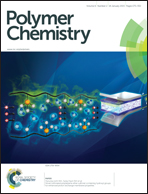Antibiofouling polymer interfaces: poly(ethylene glycol) and other promising candidates
Abstract
Nonspecific protein adsorption and/or microbial adsorption on biomedical materials adversely affects the efficacy of a range of biomedical systems, from implants and biosensors to nanoparticles. To address this problem, antibiofouling polymers can be coated on biomedical devices or built into nanoparticles to confer protein and/or microbial repellent properties. The current review provides an overview of the range of synthetic polymers currently used to this end and explores their biomedical potential. The most widely-used antifouling polymer, poly(ethylene glycol) (PEG) is reviewed alongside several promising alternatives, including zwitterionic polymers, poly(hydroxyfunctional acrylates), poly(2-oxazoline)s, poly(vinylpyrrolidone), poly(glycerol), peptides and peptoids. For each material, notable applications for both nanomedicine and macroscopic surface coatings are highlighted.


 Please wait while we load your content...
Please wait while we load your content...